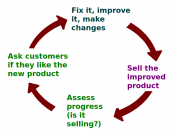The analysis of marketing concept
Marketing nowadays has occupied a more and more important position in organisations, even in the world's economics. The success of an organisation may deeply affected by marketing. Inevitably, some arguments are formed along with the marketing development, such as 'it is argued that the marketing concept is a force, which should pervade the whole organisation and as such is an integral part of the strategic management process '. In this article, I would like to discuss the argument that I mentioned above.
The first part of my article is to identify and discuss the major pillars that support the marketing concept.
The definition of marketing is that 'marketing is a societal process by which individuals and groups obtain what they need and want through creating, offering, and freely exchanging products and services of value with others' .(Philip, P9) But a leading management theorist named Peter Drucker says that ' there will always, one can assume, be need for some selling.
But the aim of marketing is to make selling superfluous'. He describes that the aim of marketing is to get to know and understand the customers very well that the product or service fits for them and sells itself. Therefore, marketing should result in a customer who is ready to buy, then is to make the product or service available. Marketing concept means that marketing is not just about selling, it is also not a specialised activity. It encircles the entire business. It is the whole business seen from the point of view of the final result, that is, from the customer's viewpoint. Therefore, Marketing's concern and responsibility must permeate and pervade all areas of the organisation.
The major pillars that support the marketing concept are: customer orientation, integrated marketing and customer satisfaction.
Customer orientation is about customer needs and wants. To find out the customer orientation, one of the most important elements for organisations is to choose the target markets carefully and then make a complete marketing programme. Most organisations now realise that they cannot effectively serve all the customers in a same market. Take car designing for an example, when the car manufacturing firm is developing a new car, the firm have to make some decisions such as should it be a four or five-seat model with a 2000cc or 3000cc engine? Should it have leather or fabric seats? The most important factor when making the decisions is customer demand. Some customer may want a five-seat 2000cc model with leather seats, meanwhile, some customers may want a four-seat 3000cc model with fabric seats. There is a solution that might work is to develop a five-seat 2500cc model with leather seats and fabric decoration. In a short, 'target marketing is the process of selecting one or more market segments and then developing a product and offer which is aimed specifically at those segments'. (Dennis, P97) Also a fact of that, even an organisation can defined its target market, it may not be able to understand the customers' needs correctly. For example, there was a furniture manufacturing company in China that designed a kind of new style double bed which was multifunctional. When it was first shown in a big shopping mall, it attracted a great number of people to surround by. Unfortunately, none bought the bed that day. The reason was simple, because that double bed was priced at 5700, but the average price of high quality double beds in China was around 2500. In that case, many customers could not afford such a high price for a double bed. So understanding customer needs is quite essential in the field of marketing. Marketers need to probe further the customers' needs. But the customer needs and wants can change, and making the existing products obsolete. For example, one of your competitors may develop a new product that a group of your customers may find more attractive. Because of this, organisations must continuously vary their products or services to keep them relevant to the customers' changing needs. There are some questions that need to be considered by the marketers, such as: who are the existing and potential customers? What are their current and future needs? How much can they afford? And why do they buy? In response to the customers, organisations began to adopt the marketing concept which involves that: focusing on customer needs before developing the new product. Aligning all functions of the organisation to focus on those needs and realising a profit by satisfying customer needs successfully over a long-term.
'When all the company's departments work together to serve the customer's interests, the result is integrated marketing'. (Philip, P23) Unfortunately, not all staffs in organisations are trained to work for customers and coordinate with them. They haven't realised that if no customer, then no staff and also no profit. According to Philip Kotler: 'integrated marketing takes place on two levels'. First of all, the various marketing functions, such as sales force advertising, customer service, product management, and marketing research that must work together. All these functions should be coordinated from the customers' sight. Actually, the manager of each department may have disagreement to others. Secondly, marketing must be clasped by the other departments, which means that marketing is not as much as a department of an organisation's business orientation. Furthermore, how can all the departments work together for customers? I think it could be simply understood as, the job of the top management is to hire and support good middle managers to motivate the front-line people who meet, serve and satisfy the customers to serve the customers better and better.
Customer satisfaction, in my opinion, is the most important pillar to support marketing concept. A brimful organisation usually satisfy customer needs better than its competitors. It is because that, firstly, a satisfied customer means good publicity. For example, if one customer is satisfied, he or she will probably talk to other nine people, and then more and more customers may be attracted. Secondly, is repeat business. But the business can be repeated only if satisfied. The ampliative business and the good publicity establish a stable and comprehensive prestige which resulted in profit. For example, Haire is one of the most popular brands in the field of home appliances. It is well-known as its after service. One customer who has enjoyed Haire's after service may persuade his or her friends or relatives to buy Haire as well, in the case the selling of Haire rises quickly.
These three pillars I analysed above support the marketing concept effectively. In the second part of the article, I would like to use Mcdonal's as a case study to analyse how these three pillars support marketing concept in true-life.
Customer orientation. As many people especially in western countries are like to eat burgers, Mcdonal's puts its emphasis on selling burgers. Obviously, wherever in which country, the target markets of Mcdonal's are children and young people. Mcdonal's usually put some little toys or some other little funny playthings into the meal boxes to attract children. Sometimes, children may go to buy Mcdonal's because they like the toys. To satisfied the changing needs of target customer and keep the selling rate steadily, Mcdonal's would change the toys and develop new taste of food oftenly.
Integrated marketing. All departments of Mcdonald's are all work for customer's needs. Sales department would not only to produce the products, but also would try to convince to buy them through the advertising. Before producing a product, they may ask two key questions: can we sell the product? Can we charge enough for it? Whatever, all they are considering for are customers' needs. There are more and more different fast food restaurants existing nowadays, so the other goal of sales department is to beat the competitors. In this situation, the sales department must to find out the answer of how to keep the existing customers and attract more potential customers. Marketing was a function that was performed after product was developed and produced. Even today, many people use the word 'marketing' when they really mean 'sales'. In my point of view, marketing and sales have some same characters. Marketing aimed to research what people wants and needs. Also, when the product has been developed and produced, the marketing department need to plan a complete programme which is about how to keep rising the sales rate, and so on. Advertising and promotion are two types of marketing communication which can increase the publicity and prestige to attract more and more customers. Mcdonal's has spent a huge sum of money to make advertisements. People can 'touch' Mcdonal's from TV, radio, advertising board, and posts outside the world-wide chain restaurants. Mcdonal's paid more attention on media advertising, because media advertising is most effective when introducing new brands, or announcing modifications to existing products. Mcdonal's aimed to give customers information, persuade customers to consume in the restaurants and reinforce the situation. But I think Mcdonal's need to do more promotion. Promotional expenditure should not be seen as a short-term effort to gain sales, because there can be an immediate return from customers as customers want to buy things at a cheaper price. Human resource department of Mcdonal's also works for customers, it takes charge to hire and train the front-line people to serve customers better and better. But there is a defect in UK's Mcdonal's restaurant: front-line people are working slowly. Although they are smiling all the time, it cannot extinguish customer's weary, because they have waited too long. But in some Asia countries, like China, Mcdonal's staffs can work really efficient.
Customer satisfaction. Mcdonald's focuses on the customer and is organised to respond effectively to changing customer needs. They would like to try to satisfy all the customers' needs, because they believe that customer is the King. Customers are satisfied means profitability. Mcdonal's restaurants have a high quality customer service. Because Mcdonal's knows that a satisfied customer means good publicity, while an unsatisfied customer also means a bad publicity as he or she may talk to other people. In that case, the repeat business cannot be achieved, Mcdonald's might lose its prestige, and lose the profit at last. As I mentioned before, staffs work inefficiently is a defect of UK's Mcdonald's, and in Mcdonald's, you may find that you do not have many choices, so lacking of some more new style and taste food may be the other defect UK's Mcdonald's.
Marketing is a subject that touches all our lives. All business organisations have continuously to encourage their potential customers to buy their products, and they must achieve this as efficiently as possible. Most organisations have chosen the marketing concept to make profit. In this article, I try to proof how the three pillars support the modern marketing concept.
Bibliography:
Kotler, P(2003) Marketing Management. International Edition.11th Edition. Prentice Hall
Dennis,A. Ray.B(1995) Marketing Principles&Practice. 2ndEdition. Pitman publishing, London.
Baker,MJ(2000) Marketing Strategy and Management. Macmilan.
Peter Druker, Management: Tasks, Responsibilities, Practices(New York: Harper and Row, 1973), pp.64-65
Chapman, D&Cowdell, T(1998) New Public Sector Marketing. Pitman publishing, London.
Sam Hill and Glenn Rifkin(1999), Radical Marketing, HarperBusiness. New York.


